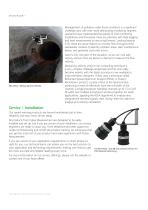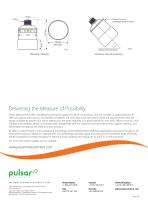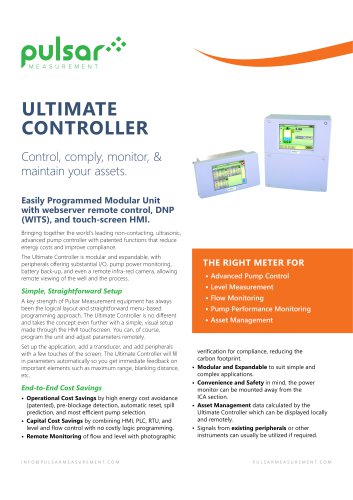 Website:
Pulsar Measurement
Website:
Pulsar Measurement
Catalog excerpts

MICROFLOW-i Non-contacting, loop powered, liquid, velocity sensor The water industry’s solution to event duration measurement in combined sewer overflows. Pulsar’s MicroFlow-i delivers accurate, repeatable velocity measurement for liquid flow, either as an individual sensor or by providing HART communication protocol or a 4-20mA loop powered signal into a SCADA system. Its lightweight, compact design makes installation simple, especially within confined spaces, and requires no interruption to normal operational flow. MicroFlow-i Options The MicroFlow range has been specified and designed to meet the demanding requirements of today’s process flow measurement applications. The unit is positioned above and at 45 degrees to the flow and measures flow velocity. The standard RS485 version is Ex mb certified for use in Zones 1 and 2, and the 2 wire loop-powered version with HART protocol is intrinsically safe (Ex ia) for Zone 0. MicroFlow-i Communication The 2-wire version can be used in digital HART mode or as a 4-20mA loop-powered device. The MicroFlow-i can be set up using a HART modem with either proprietary HART software such as PACTware, or MicroFlow HART PC software. Cable Lengths & Brackets Standard cable lengths 10 m (32.8 ft), 20 m (65.6 ft), and 30 m (98.4 ft) are available. THE RIGHT METER FOR • Event Duration Measurement • Combined Sewer Overflows • Open Channel Flow Monitoring • Remote Locations • Velocity Area Solutions The MicroFlow-i should be installed directly above the flow with the axis at 45 degrees to the flow to be measured. We have a range of brackets available that will assist with installation angles. Event Duration Measurement for Combined Sewer Overflows Event Duration Measurement (EDM) in Combined Sewer Overflow (CSO) applications has, rightly, become a significant focus for our water operators.
Open the catalog to page 1
Management of pollution under flood conditions is a significant challenge and, with ever more demanding monitoring regimes, operators have implemented thousands of CSO monitoring installations and thousands more are planned, with data logging and level measurement to record spill events. Looking beyond CSO, there are good reasons to monitor flow throughout the wastewater network to identify problem areas, alert maintenance teams, and generate corrective action. Level is only one part of the equation, as we can now add velocity sensors that are above a channel to measure the flow velocity....
Open the catalog to page 2
Technical Specifications PHYSICAL: MOUNTING OPTION SPECIFIC Sensor Body Dimensions: Sensor Body Material/ Description: Transducer Cable Extensions: Mounting Connection: Via 1” BSP back-mounted thread or 20 mm (0.8 in) via the supplied adaptor. Optional mounting bracket available from Pulsar Mounting Angle: 45° optimal and mounted at the centerline of the channel with a clear uninterrupted view Maximum Separation: ENVIRONMENTAL Enclosure Protection: ATEX Approval: Listed in the Certificate of Conformity within the manual. Velocity Range: Operational Range: Optimal Installation: Install at an...
Open the catalog to page 3
MicroFlow-i Drawing MicroFlow-i Mounting Drawing Delivering the Measure of Possibility Pulsar Measurement offers worldwide professional support for all of our products, and our network of global partners all offer full support and training. Our facilities in Malvern, UK and Largo, USA are home to technical support teams who are always available to answer your call or attend your site when required. Our global presence, with direct offices in the UK, USA, Canada, and Malaysia, allows us to create close relationships with our customers and provide service, support, training, and information...
Open the catalog to page 4All Pulsar Measurement catalogs and technical brochures
-
PULSARGUARD 2010 SERIES
2 Pages
-
PULSARGUARD 2001 SAND SENSOR
4 Pages
-
REFLECT 2-wire Radar Sensor
4 Pages
-
MICROFLOW
2 Pages
-
FLOW PULSE
2 Pages
-
Quantum 3 Sales Brochure
4 Pages
-
Quantum 2 Sales Brochure
4 Pages
-
IMP Sales Brochure
4 Pages
-
IMP Lite Sales Brochure
4 Pages
-
IMP I.S. Sales Brochure
4 Pages
-
Blackbox Level Controller
4 Pages
-
The Ultimate Controller
4 Pages
-
Radar Sensors
4 Pages
-
FlowCERT Sales Brochure
4 Pages
-
dB Ultrasonic Sensors
4 Pages
-
Ultra 4 Sales Brochure
4 Pages
-
SFM 6.1 Slurry Flow Meter
4 Pages
-
Open Channel Flow Monitors
2 Pages
-
ISM 5.0 Insertion Magmeter
4 Pages
-
DFS 5.1 Doppler Flow Switch
4 Pages
-
Model DFM 6.1
4 Pages
-
AVFM 6.1
4 Pages
-
TTFM 6.1
4 Pages











































